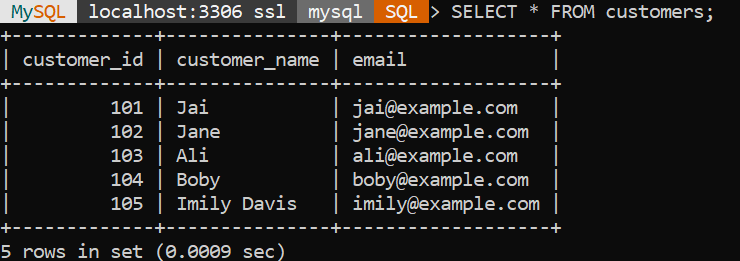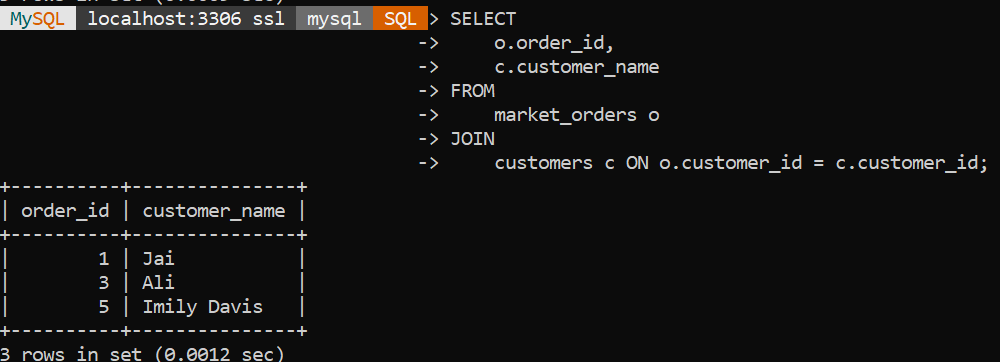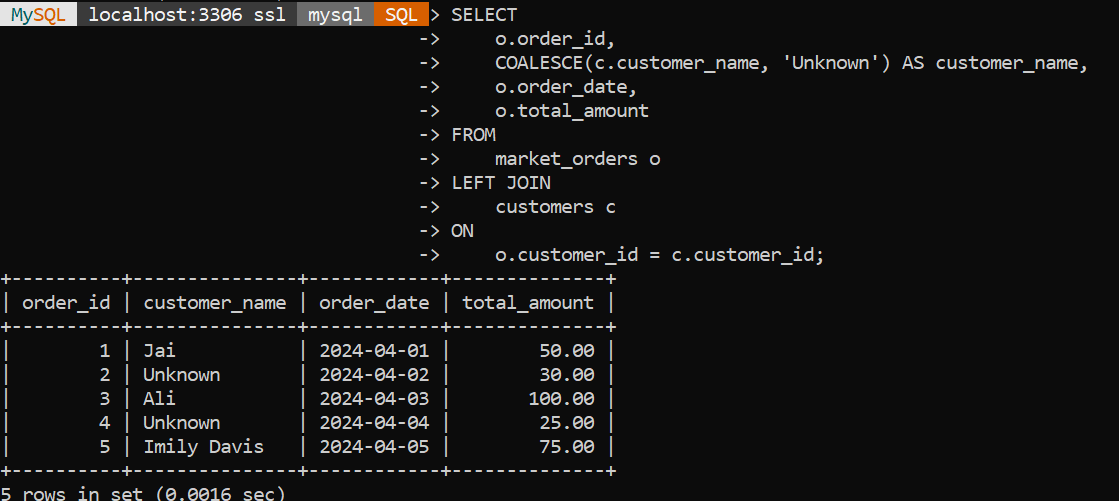A lot of SQL programming involves doing things again and using specific methods again and over. These recurrent techniques are known as “SQL patterns,” and knowing more about them is essential for database management. SQL developers frequently encounter scenarios where matching Null values becomes imperative. In this tutorial, we will learn the significance of matching nulls and employing a technique known as null masking to achieve this.
Problem of SQL Data Matching with Null Values
When we are dealing with Null values, SQL operations lead to a special problem that denotes missing or unknown data. Null does not equate to Null, in contrast to other values. This fundamental difference often leads to discrepancies when we are attempting to match data across tables based on Null values.
Example:
Imagine a retail company’s database with two tables: “market_orders” and “customers“.
Order-related data, such as the order ID and associated customer ID, are stored in the “orders” database. However, certain orders might not have a matching customer ID because of a variety of factors, including inadequate data input or new customers. This would leave the “customer_id” column with Null values.

In the same way, the “customers” table includes information on customers, such as names and addresses.

Imagine for a moment that the business has to produce a report that includes a list of all orders and the identities of the clients who placed them.
The SQL query to do this task without Null values:
SELECT
o.order_id,
c.customer_name
FROM
market_orders o
JOIN
customers c ON o.customer_id = c.customer_id;Code language: SQL (Structured Query Language) (sql)
However, issues occur when the “customer_id” column of the “orders” database has Null values. The JOIN function will fail to match an order with a customer if the order does not have a corresponding customer ID, which will, leave the report with missing data.
This is the point at which Null values become problematic. Null does not equal Null, in contrast to other values, which leads to inconsistencies in data-matching processes. In this case, using Null values to try and match orders with customers might result in error or partial results, which will compromise the report’s integrity.
Also Read: Handle NULL When Working with ORDER BY Clause in SQL
Matching Nulls by Masking Nulls
A sophisticated SQL technique called Matching Nulls by Masking Nulls was created to address the complexities of Null value comparison. The core idea behind this method is Null masking, which allows for smooth data matching and comparison by substituting predetermined placeholders for Null values.
We can use COALESCE to implement this. We can ensure consistency and correctness in data-matching processes by methodically replacing Null values with default placeholders by utilizing COALESCE.
Example:
In the below query, if there is no corresponding customer present, the COALESCE function ensures that it is replacing Null values in the “customer_name” column with ‘Unknown’.
SELECT
o.order_id,
COALESCE(c.customer_name, 'Unknown') AS customer_name,
o.order_date,
o.total_amount
FROM
market_orders o
LEFT JOIN
customers c
ON
o.customer_id = c.customer_id;Code language: SQL (Structured Query Language) (sql)
As you can see for orders that contained Null values in “customer_id” (orders 2 and 4), the customer name is replaced with ‘Unknown’, as specified by the COALESCE function. This makes sure that you receive accurate reporting on transaction data, even when customer information is missing or incomplete.
Conclusion
Exploring SQL techniques like Matching Nulls by Masking Nulls enables you to skillfully handle complicated data-matching situations. However, it is important to know that it is better to work on your model rather than using Null masking statements in JOIN conditions. However, this process can be utilized in worse-case scenarios. We hope you enjoyed it.
Reference
https://stackoverflow.com/questions/12853944/why-in-sql-null-cant-match-with-null
